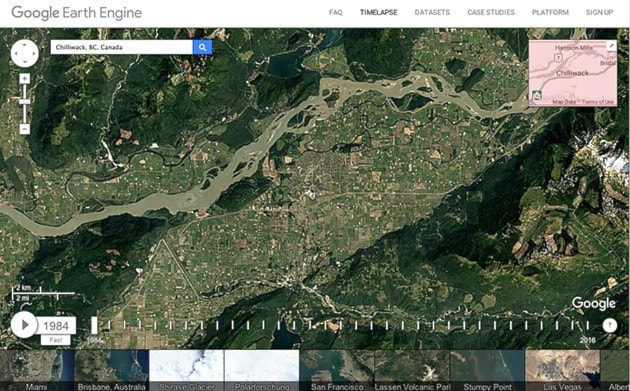A new online Google tool offers a glimpse at how the world has changed over the past 32 years, including here in Chilliwack.
The tool is called Timelapse, and shows aerial imaging taken annually from 1984 to 2016. Users can zoom in or out, to watch the whole world change, or just a small part of it. The timelapse can be sped up, slowed down, and paused for closer studying. (Try it out above, or on Google Earth.)
The 32-year difference in Chilliwack shows rapid growth in some key areas, including Chilliwack Mountain, Promontory, Little Mountain, and most recently, Eagle Landing. Further up the valley, residential density increased dramatically in both Popkum and Agassiz over the timeframe.
In 1984, Chilliwack's most populated area is north of the highway, with the same general road layout as it has today but with larger residential lots. In Sardis at the time, most of the development is surrounding the former CFB Chilliwack, with very little of today's existing neighbourhood structure.
Two of the most dramatic changes are in the hillsides. The first is the change of Promontory from a rolling hill with few roads and homes. That begins to change in the late 1990s, and sees steady growth until about 2009.
But the southern base of Chilliwack Mountain stretching out to Eagle Landing has seen the most recent changes, as green areas were filled in with commerial and industrial developments over the past decade.
And in the centre of Chilliwack north, there remains the dark green patch of Little Mountain. While the hill has lost some of its green space over the past 32 years, growth there mostly stopped in the early 1990s. A grassroots movement to save the area from a 20-acre development was successful in 1993. The group, which included Anne Russell, Daryl Rose and Susan Hainstock, worried Little Mountain would be the last wild area in Chilliwack.
"We don't disagree that you have to develop on the hillside," Russell told The Progress then. "We just want to be able to preserve a healthy chunk of it."
See something of interest? Add your thoughts in the comments below.
